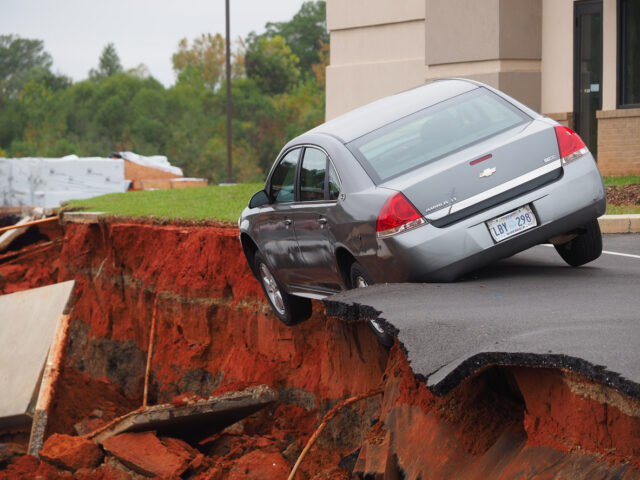Sinkholes are a natural phenomenon caused by the erosion of rock layers due to water.
However, human interference in the shape of construction, mining and climate change has increased the incidences of sinkholes globally. A 2018 study using Florida as a case study demonstrated that for every 0.1 degree Celsius rise in global temperature, the number of sinkholes increases 1 to 3 per cent.
Sinkholes can appear suddenly and without warning, endangering people and property and posing a challenge for engineers seeking to prevent them, particularly in urban environments.
Six people were killed in China in 2020 when a bus fell into a 10-metre-wide sinkhole that appeared in the street outside a hospital in Xining in Qinghai province. In the UK, a sinkhole caused the partial collapse of four houses in a Manchester street in January.
During the floods that affected eastern Australia following record rainfall in March, three people fell into a sinkhole that suddenly opened beneath their feet as they observed the swollen Mehi River at Moree, in northern NSW. One person climbed out of the sinkhole, while Fire and Rescue NSW rescued two others.
On January 8 in Naples, a giant sinkhole appeared in the carpark of a hospital. The sinkhole, 20 metres deep and encompassing 2,000 square metres, caused the closure of a nearby COVID-19 recovery facility. Fortunately, no one was injured in the incident.

The Naples example illustrates the role soil structure plays in the formation of sinkholes. As Dr Arya Assadi Langroudi, Senior Lecturer in Geotechnical Engineering at the University of East London, explains in an article for The Conversation, Naples is a city prone to sinkholes thanks to factors including soil type and centuries of quarrying that created cavities under the city. In December 2020, the city experienced three days of torrential rain, which dissolved soluble carbonates in the topsoil, “loosening the cavity and triggering the sinkhole”.
Can we prevent sinkholes?
In conventional construction, foundations are built by compacting and grouting the natural ground, Langroudi explains. “Natural pores in soil are either destroyed or filled with chemicals. For soil, less pores means better strength, but also means penetration of larger volumes of rainwater into the ground through fewer and narrower openings. This high-intensity seepage can wash away soluble minerals, loosen the soil around buried cavities, and trigger sinkholes.”
Langroudi leads a team that studies methods to strengthen natural voids in urban soil to minimise the risk of geohazards such as sinkholes. “We engineer natural bacteria in the crust to discharge a very sticky glue-like gel and bind soil grains together. Beneath, the topsoil is designed to be light, alive and breathable, rich in organic fibres that weave soil grains together,” he writes.
“We engineer these organic fibres to allow them to stretch far more before they rupture during ground movements. The subsoil in urban areas is usually rich in construction wastes. We develop ways for these wastes to feed on the carbon dioxide in soil and transform into very strong fibres.”
Langroudi believes a more scientific approach to geotechnical engineering is vital to reducing the incidence of sinkholes.














